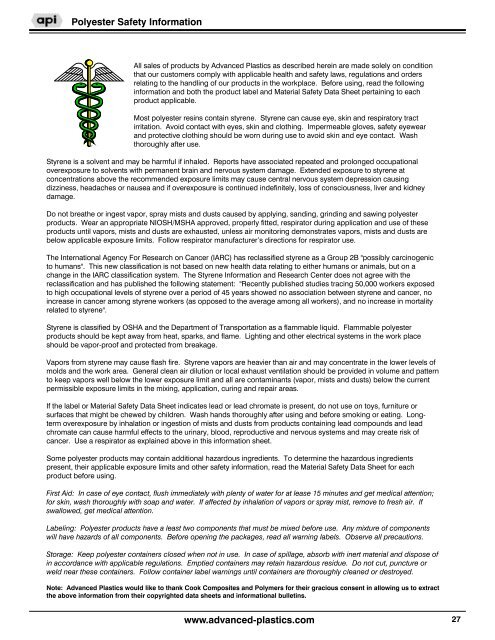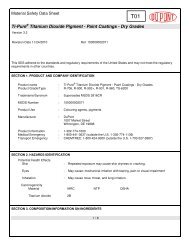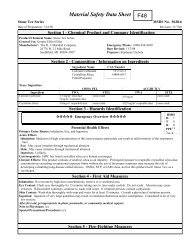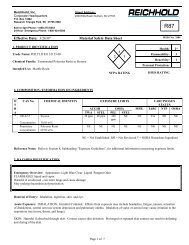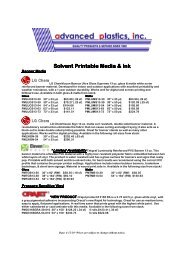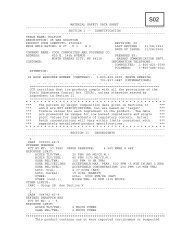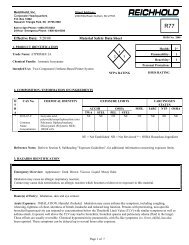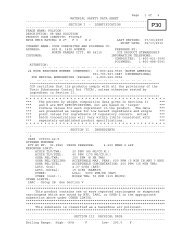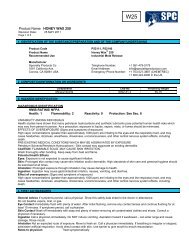Polyester Safety InformationAll sales of products by <strong>Advanced</strong> <strong>Plastics</strong> as described herein are made solely on conditionthat our customers comply with applicable health and safety laws, regulations and ordersrelating to the handling of our products in the workplace. Before using, read the followinginformation and both the product label and Material Safety Data Sheet pertaining to eachproduct applicable.Most polyester resins contain styrene. Styrene can cause eye, skin and respiratory tractirritation. Avoid contact with eyes, skin and clothing. Impermeable gloves, safety eyewearand protective clothing should be worn during use to avoid skin and eye contact. Washthoroughly after use.Styrene is a solvent and may be harmful if inhaled. Reports have associated repeated and prolonged occupationaloverexposure to solvents with permanent brain and nervous system damage. Extended exposure to styrene atconcentrations above the recommended exposure limits may cause central nervous system depression causingdizziness, headaches or nausea and if overexposure is continued indefinitely, loss of consciousness, liver and kidneydamage.Do not breathe or ingest vapor, spray mists and dusts caused by applying, sanding, grinding and sawing polyesterproducts. Wear an appropriate NIOSH/MSHA approved, properly fitted, respirator during application and use of theseproducts until vapors, mists and dusts are exhausted, unless air monitoring demonstrates vapors, mists and dusts arebelow applicable exposure limits. Follow respirator manufacturer’s directions for respirator use.The International Agency For Research on Cancer (IARC) has reclassified styrene as a Group 2B "possibly carcinogenicto humans". This new classification is not based on new health data relating to either humans or animals, but on achange in the IARC classification system. The Styrene Information and Research Center does not agree with thereclassification and has published the following statement: "Recently published studies tracing 50,000 workers exposedto high occupational levels of styrene over a period of 45 years showed no association between styrene and cancer, noincrease in cancer among styrene workers (as opposed to the average among all workers), and no increase in mortalityrelated to styrene".Styrene is classified by OSHA and the Department of Transportation as a flammable liquid. Flammable polyesterproducts should be kept away from heat, sparks, and flame. Lighting and other electrical systems in the work placeshould be vapor-proof and protected from breakage.Vapors from styrene may cause flash fire. Styrene vapors are heavier than air and may concentrate in the lower levels ofmolds and the work area. General clean air dilution or local exhaust ventilation should be provided in volume and patternto keep vapors well below the lower exposure limit and all are contaminants (vapor, mists and dusts) below the currentpermissible exposure limits in the mixing, application, curing and repair areas.If the label or Material Safety Data Sheet indicates lead or lead chromate is present, do not use on toys, furniture orsurfaces that might be chewed by children. Wash hands thoroughly after using and before smoking or eating. Longtermoverexposure by inhalation or ingestion of mists and dusts from products containing lead compounds and leadchromate can cause harmful effects to the urinary, blood, reproductive and nervous systems and may create risk ofcancer. Use a respirator as explained above in this information sheet.Some polyester products may contain additional hazardous ingredients. To determine the hazardous ingredientspresent, their applicable exposure limits and other safety information, read the Material Safety Data Sheet for eachproduct before using.First Aid: In case of eye contact, flush immediately with plenty of water for at lease 15 minutes and get medical attention;for skin, wash thoroughly with soap and water. If affected by inhalation of vapors or spray mist, remove to fresh air. Ifswallowed, get medical attention.Labeling: Polyester products have a least two components that must be mixed before use. Any mixture of componentswill have hazards of all components. Before opening the packages, read all warning labels. Observe all precautions.Storage: Keep polyester containers closed when not in use. In case of spillage, absorb with inert material and dispose ofin accordance with applicable regulations. Emptied containers may retain hazardous residue. Do not cut, puncture orweld near these containers. Follow container label warnings until containers are thoroughly cleaned or destroyed.Note: <strong>Advanced</strong> <strong>Plastics</strong> would like to thank Cook <strong>Composites</strong> and Polymers for their gracious consent in allowing us to extractthe above information from their copyrighted data sheets and informational bulletins.www.advanced-plastics.com 27
Terms and ConditionsStandard Terms and Conditions1. Buyer shall pay, in addition to the prices stated, the amountof any sales, use or similar taxes with respect to the materialssold. Due to Federal/State tax laws, Seller will be required tocharge sales tax, where applicable, until a valid, signed resale/equipment tax certificate is received.2. Seller’s records as to the weights, volumes and quantities ofmaterials shipped shall govern except in case of proven error.3. INITIAL ORDERS ARE SHIPPED COD CASH OR CERTIFIEDCHECK UNLESS/UNTIL PRIOR COORDINATION IS MADE.VISA, MASTERCARD and DISCOVER ARE ACCEPTED FORCOD SALES ONLY. Open account privileges are available forcustomers having an acceptable payment history. Extension ofopen account privileges are of the sole discretion of Seller.Seller reserves the right to alter, compromise, accelerate, extendor exchange the terms of sale without notice. Should a creditavailability be granted by Seller, all decisions with respect to theextension or continuation shall be in the sole discretion of Seller.Seller may terminate any credit availability within Seller’s solediscretion at any time without notice. Seller may require Buyerto provide some form of Security to Seller in consideration ofcredit extension. Upon approval agreed in writing by seller, theterms of payment under this application shall be NET THIRTY(30) DAYS FROM THE DATE OF INVOICE, or as otherwisedetermined by SELLER, and shall be made in United Statesfunds immediately available without discount. Seller shall notbe entitled to set off against payments owing any amountsowing or alleged to be owing from Seller to Buyer for adjustments,set-offs or claims hereunder.4. Seller warrants that the material sold hereunder shall meetSeller’s standard written specifications. Buyer shall inspect thematerial for shortages and visible defects upon delivery andshall note them on carrier’s receipt. Within thirty (30) days aftereach shipment reaches the destination designated by Buyer,Buyer shall further inspect the material and promptly notifySeller in writing of any other defects. Failure to so inspect, ornotify shall waive all claims and defenses against Seller basedon shortages or defects reasonably discoverable by inspection.Buyer shall determine within thirty (30) days after receipt of eachshipment by testing and all other means, the suitability ofSeller’s materials for Buyer’s particular purpose of purposes,regardless of whether disclosed to any Seller’s representatives.The sole remedy of Buyer for materials not meeting Seller’sstandard written specifications shall be replacement by Seller ofa like amount of material after reasonable opportunity toinvestigate Buyer’s claim. THE WARRANTY CONTAINED INTHE PARAGRAPH IS PROVIDED IN PLACE OF ALL WARRAN-TIES, EXPRESS OR IMPLIED, INCLUDING THE WARRANTY OFMERCHANTABILITY. Seller shall not be liable for subsequentialof special damages. Buyer agrees that it will not rely upon, andSeller does not authorize, any representations, warranties oragreements made by any of Seller’s representatives, except asset forth herein and in Seller’s written specifications. In connection,Buyer acknowledges that Seller’s advertising material isintended only to present brief summary descriptions of Seller’smaterials for potential buyers and is not intended to substitutefor testing of such materials and compliance withSeller’s written specifications. Further, not withstanding suchtechnical consultation as may be furnished by Seller, Buyeragrees to hold Seller harmless against any liability resultingfrom Buyer’s use or resale of such materials after processing orcombinations with other materials.If Seller agrees to accept items for return or credit, it is theSeller’s sole option to charge an appropriate restocking fee, atthe Seller’s discretion. Seller requires a reasonable period oftime process credit memorandum and issue check payable toBuyer.5. Seller shall not be liable for any failure to deliver or any delayin delivery which shall be caused, directly or indirectly, and inwhole or in part, by fire; flood; rain or windstorm; explosion;machinery or equipment breakdown; sabotage; strike or workstoppages; civil disturbances; war (whether or not officiallydeclared); voluntary or mandatory compliance with law orregulation or a policy of any governmental department oragency or the order of any court; shortages of labor, rawmaterials, equipment, fuel or power; unavailability or delays oftransportation facilities; any act of God; or any other causesbeyond the reasonable control of Seller. In any such events,Seller shall use its best efforts to allocate available supplies ofthe materials covered by this agreement proportionately amongit’s customers including Buyer.6. Any modifications of these Standard Terms and Conditionsshall not be binding on Seller unless signed on behalf of Sellerby a representative authorized to do so, regardless of whetherSeller commences shipping material ordered hereunder andaccepts payment therefor.7. Risk or loss of damage to materials shall be sold shall passto Buyer upon deliver to the carrier. In the event of loss ordamage in shipping, Buyer shall obtain a written statement fromthe carrier’s representative as to the circumstances of the lossor damage and deliver a copy to Seller.8. Any provisions contained in Buyer’s purchase orders whichare not consistent with these Standard Terms and Conditionsare not accepted by Seller.9. Orders shall not deemed acceptable by Seller until receivedand acceptance is acknowledged by Seller.10. BUYER AGREES THAT IN EVENT OF DEFAULT IN THEPAYMENT OF ANY AMOUNT DUE, AND IF THE ACCOUNTIS PLACED IN THE HANDS OF AN AGENCY OR ATTORNEYFOR COLLECTION OR LEGAL ACTION, TO PAY AN ADDI-TIONAL CHARGE EQUAL TO THE COST OF COLLECTIONINCLUDING AGENCY AND ATTORNEY FEES AND COURTCOSTS INCURRED AND PERMITTED BY LAWS GOVERN-ING THESE TRANSACTIONS.28www.advanced-plastics.com


